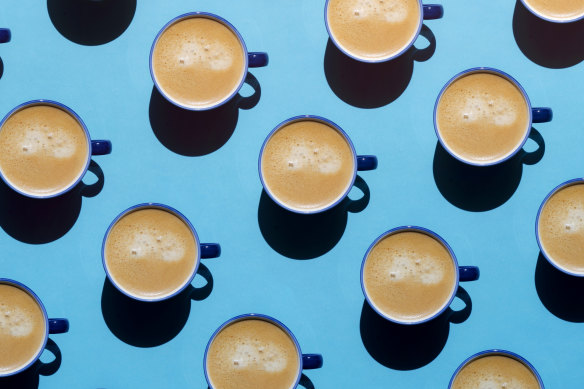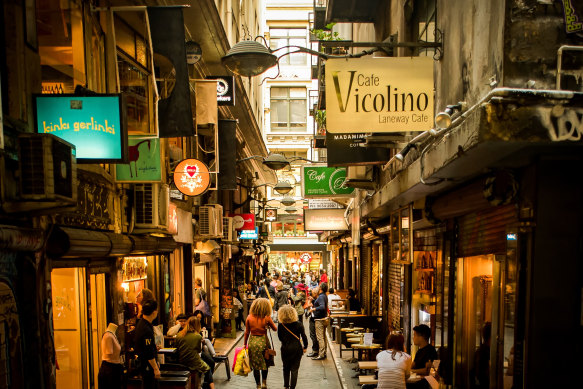This was published 1 year ago
Opinion
Could limiting our number of cafes prevent the dreaded $7 latte?
William Bennett
Money contributorThere’s been much ado about how we should be preparing to pay much more for coffee, but Australia’s proliferation of cafes means addicts like me need not get too jittery.
You’ve no doubt heard that recent spikes in coffee prices have sent Italians panicking, with the price of arabica beans hitting a new all-time high last month, a rise of 40 per cent in the past year.

Worried about a $7 latte? Regulating our number of coffee shops is unlikely to be the answer.Credit: iStock
But here in Australia, coffee prices have remained remarkably inflation-proof. The average price of a coffee only increased 25¢ from 2022 to 2023, according to data from payments provider Square.
While it might not seem that way, Australia’s coffee prices are among the cheapest in the world, according to The Conversation’s flat white index, which sampled the costs of flat whites globally.
As someone with black coffee running through their veins, it’s a comforting reminder that at least some have it worse in other parts of the world.
I can report after living for a year in Manhattan that you will easily pay over $8 for a Starbucks “coffee”, something most Australians would have to be paid to drink. In London, expats report paying more than $7 depending on the zone they live in.
It seems unlikely that coffee will hit that feared $7 the doomsayers are predicting as people would simply stop buying it.
How is it possible that our coffee is the cheapest when we import all our beans, pay the highest wages and have some of the most expensive energy costs in the world? The answer is that our love of coffee – and the proliferation of coffee shops – means that fierce competition keeps our prices low.
“We have so many cafes per capita, the competition means we are keeping prices low to not lose business,” says Phillip Di Bella, founder of the Coffee Commune in Brisbane. “Coffee operators 15 years ago enjoyed roughly 30 per cent profit margins, and as costs have risen, they have chosen to absorb much of the cost increases.” Di Bella estimates that businesses are now making $1 profit per cup.
Di Bella caused a froth on social media last month, arguing there were too many cafes in Australia and suggesting that “some sort of regulation” was needed to stop cafes opening on every corner.
“Competition is great but [an] oversaturated market means many mum-and-dad operators fail, losing their money, property and taking down other mum-and-dad supplier businesses with them,” he says.
According to Di Bella, local governments should monitor new cafe licences more closely. He points to Italy, where local demand and supply are assessed before new cafe licences are issued to limit business failures and avoid saturation.
Historically, Rome regulated the price of espresso, but controls ended decades ago. It’s likely that any cap on cafes would only increase prices for us coffee addicts.
While the number of cafes in Australia has indeed increased considerably, so too has the number of insolvencies in hospitality, which increased at the fastest rate on record in 2024, according to ASIC data. Almost one in 10 cafes, coffee shops and restaurants are tipped to close in the coming year.
“I would not support regulation of the number of cafes in a given area – that would be protecting existing businesses from competition and would stifle innovation,” says independent economist Saul Eslake.
Being a discretionary good, coffee demand is more “elastic” and substitutable, which means consumers have been able to “pre-drink” coffee made at home and just go out for one coffee.
It seems unlikely that coffee will hit that feared $7 the doomsayers are predicting, as people would simply stop buying it.
Spending at cafes and restaurants fell 12 per cent in the 2024 financial year, as people switched to more affordable options, according to the Commonwealth Bank’s Cost of Living Insights report. The Reserve Bank expects households to increase spending in the second half of the year, so hopefully the worst has passed for cafe owners.
“We have found other ways to make ends meet, increasing prices on food and creating a range of merchandise”, says the manager of a popular laneway cafe in Melbourne, who declined to be named to avoid creating bad blood with their neighbours.
“I know some cafes nearby that have reduced the size of their takeaway cups and others that have reduced the size of their espresso shots without customers knowing.”
True coffee drinkers – those who drink black coffee – are also doing our bit to subsidise those degenerate dairy (and milk juice) drinkers, with many cafes now charging the same prices for black and white coffee.
The recent rise in bean prices is unlikely to move the needle, with beans only accounting for 12 per cent of the cost of producing a latte, but perhaps coffeenomics also works in long and variable lags.
The vast majority of the cost of a cup of coffee – more than 65 per cent – is attributed to labour and overheads.

Spending at cafes and restaurants fell 12 per cent in the 2024 financial year.Credit: iStock
Aussie expat Robbie Lecchino recently closed his cafe All the Kings Horses in Manhattan’s East Village as he was unable to make ends meet despite charging $8 for a flat white.
“I was charging $US5.5 for a flat white, plus tax plus tip, which is cheap by New York standards”, says Lecchino. Coffee near Central Park is pushing $US9.25 for an almond milk latte.
“Even with $US6 coffees, we couldn’t make ends meet with wages and overheads, it was the main reason I had to close the cafe.”
I count myself lucky I’m just a coffee addict who doesn’t drink beer or have a sweet tooth for chocolate, the prices of which have soared this year.
With housing affordability hitting new records, at least our cheap coffee is taking a bit of the depresso out of the cost-of-living crisis. So Australians let us all rejoice, for we’ve strong and cheap coffee.
Expert tips on how to save, invest and make the most of your money delivered to your inbox every Sunday. Sign up for our Real Money newsletter.